Environmental Comparison of Energy Solutions for Heating and Cooling
Abstract
1. Introduction
2. Heating and Cooling Buildings
2.1. Conventional Approaches
2.2. ectogridTM
- Grid of pipes connecting the buildings and the components.
- Components in the buildings, mainly heat pumps and cooling machines.
- A passive balancing unit, i.e., a hot water storage tank that evens out daily demand variations.
- An active balancing unit, i.e., an external source of energy, such as a reversible heat pump, district heating or cooling, or geothermal energy.
2.3. Perspectives on Energy Solutions
2.4. Environmental Impact
3. Case Studies
4. Method
4.1. Calculations of Energy Use
4.1.1. Case 1—Electricity and Heat Use
- Heat demand
- System losses
- District cooling production
- Distribution pumps
- District cooling pumps
- District cooling production
- District cooling pumps
- District heating pumps
- Energy losses
- Heat generated by the district cooling pumps
4.1.2. Case 2—Electricity and Heat Use
- Heat demand
- System losses
- District cooling production
- Distribution pumps
- District cooling pumps
- Internal balancing
- Remaining energy demand
- Active balancing unit
- Circulations pump
- Energy transmissions to the ground
- District cooling production
- District cooling pumps
- District heating pumps
- Energy losses
- Heat generated by the district cooling pumps
4.1.3. Case 3—Electricity and Heat Use
- Heat pumps for heat production
- Heat pumps for cooling production
- Circulation pump
- Cooling machines
- Coolers
4.2. Quantification of the Environmental Impact
5. Results
5.1. Energy Use for the Different Cases
5.2. Environmental Evaluation for Higher Emission Factors
5.2.1. District Heating
5.2.2. Electricity
5.2.3. A European Context
6. Discussion
6.1. Some Aspects of the Data
6.2. Analysis of Environmental Impact
6.3. Wider Perspective
7. Conclusions
Author Contributions
Funding
Acknowledgments
Conflicts of Interest
References
- IPCC. Climate Change 2014: Synthesis Report. Contribution of Working Groups I, II and III to the Fifth Assessment Report of the Intergovernmental Panel on Climate Change; IPCC: Geneva, Switzerland, 2014. [Google Scholar]
- Frederiksen, S.; Werner, S. District Heating and Cooling, 1st ed.; Studentlitteratur: Lund, Sweden, 2013. [Google Scholar]
- Värmemarknadskommittén. Överenskommelse i Värmemarknadskommittén 2018; Energiföretagen Sverige: Stockholm, Sweden, 2018. [Google Scholar]
- Gode, J.; Byman, K.; Persson, A.; Trygg, L. Miljövärdering av el ur Systemperspektiv; IVL Svenska Miljöinstitutet: Stockholm, Sweden, 2009. [Google Scholar]
- E.ON. ECTOGRIDTM. Available online: http://ectogrid.com/ (accessed on 21 November 2019).
- E.ON. The ECTOGRIDTM technology. Available online: http://ectogrid.com/business-customer/ (accessed on 21 November 2019).
- Game Changing Technology Connects Medicon Village Buildings. Available online: https://www.mediconvillage.se/sv/game-changing-technology-connects-medicon-village-buildings (accessed on 21 November 2019).
- Kadir, S.; Özkan, S. ECTOGRIDTM. The Competitiveness of a Low Temperature District Network in Germany and United Kingdom. Master’s Thesis, KTH Industrial Engineering and Management, Stockholm, Sweden, 21 February 2018. [Google Scholar]
- Alvarez, H. Energiteknik Del II, 3rd ed.; Studentlitteratur: Lund, Sweden, 2006. [Google Scholar]
- Werner, S. Energiförsörjning, 1st ed.; Studentlitteratur: Lund, Sweden, 2016. [Google Scholar]
- IEA Heat Pump Center. Heat Pump Concepts for Nearly Zero-Energy; IEA Heat Pump Center: Borås, Sweden, 2016. [Google Scholar]
- Fernández, F.J.; Folgueras, M.B.; Suárez, I. Energy study in water loop heat pump systems for office buildings in the Iberian Peninsula. Energy Procedia 2017, 136, 91–96. [Google Scholar] [CrossRef]
- Omer, A.M. Ground-source heat pumps systems and applications. Renew. Sustain. Energy Rev. 2008, 12, 344–371. [Google Scholar] [CrossRef]
- Spitler, J.; Bernier, M. Vertical borehole ground heat exchanger design methods. Adv. Ground-Source Heat Pump Syst. 2016, 29–61. [Google Scholar] [CrossRef]
- Gehlin, S. Borehole thermal energy storage. Adv. Ground-Source Heat Pump Syst. 2016, 295–327. [Google Scholar]
- Kim, Y.; Lee, J.; Jeon, S. Hybrid ground-source heat pump systems. Adv. Ground-Source Heat Pump Syst. 2016, 331–357. [Google Scholar] [CrossRef]
- Akhlaghi, S.; Carlson, S. Mot Fjärde Generationens Fjärrvärme: En Fallstudie av Möjliga Lösningar i Malmö; Lunds universitet: Lund, Sweden, 2016. [Google Scholar]
- Lund, H.; Werner, S.; Wiltshire, R.; Svendsen, S.; Thorsen, J.E.; Hvelplund, F.; Mathiesen, B.V. 4th Generation District Heating (4GDH): Integrating smart thermal grids into future sustainable energy systems. Energy 2014, 68, 1–11. [Google Scholar] [CrossRef]
- Bünning, F.; Wetter, M.; Fuchs, M.; Müller, D. Bidirectional low temperature district energy systems with agent-based control. App. Energy 2018, 209, 502–515. [Google Scholar] [CrossRef]
- Karlsson, B.; Lundström, L.; Eriksson, O. Energivärdering av Byggnader; Fjärrsyn Svensk Fjärrvärme: Stockholm, Sweden, 2016. [Google Scholar]
- Pellegrini, M.; Bianchini, A. The Innovative Concept of Cold District Heating Networks. Energies 2018, 11, 236. [Google Scholar] [CrossRef]
- EME Analys AB and Profu in Göteborg AB. Miljövärdering av el—Med Fokus på Utsläpp av Koldioxid; Elforsk AB: Stockholm, Sweden, 2017. [Google Scholar]
- Energi, S. Vägledning Angående Ursprungsmärkning av el; Energiföretagen: Stockholm, Sweden, 2012. [Google Scholar]
- Gode, J.; Martinsson, F.; Hagberg, L.; Öman, A.; Höglund, J.; Palm, D. Miljöfaktaboken 2011—Uppskattade Emissionsfaktorer för Bränslen, el, Värme och Transporter; Värmeforsk Service AB: Stockholm, Sweden, 2011. [Google Scholar]
- E.ON Is Building the World’s First ECTOGRIDTM at Medicon Village. Available online: http://ectogrid.com/use-cases/medicon-village/ (accessed on 22 November 2019).
- Ekestubbe, J.; (E.ON, Malmö, Sweden). Personal Communication, 12 March 2018.
- Microsoft Excel for Office; Microsoft Corporation: Redmond, WA, USA, 2018.
- Gierlow, M.; (Kraftringen Energi, Lund, Sweden). Personal Communication, 7 March 2018.
- Alvarez, H. Energiteknik Del I, 2nd ed.; Studentlitteratur: Lund, Sweden, 2003. [Google Scholar]
- Rosén, P.; (E.ON, Malmö, Sweden). Personal Communication, 1 March 2018.
- Storck, K.; Karlsson, M.; Andersson, I.; Renner, J.; Loyd, D. Formelsamling i termo-och Fluiddynamik; Linköping University: Linköping, Sweden, 2010. [Google Scholar]
- Holm & Holm. Wall Thickness and Weight of PE Pipes. Available online: https://www.holm-holm.dk/en/plastic-info/wall-thickness/ (accessed on 14 February 2018).
- The Engineering Toolbox, 2003. Thermal Conductivity of Common Materials and Gases. Available online: https://www.engineeringtoolbox.com/thermal-conductivity-d_429.html (accessed on 14 February 2018).
- Commercial Refrigeration. Available online: https://www.carrier.com/commercial-refrigeration/en/uk/solutions/ (accessed on 15 June 2018).
- Martinsson, F.; Gode, J.; Arnell, J.; Höglund, J. Emissonsfaktor för Nordisk Elproduktionsmix. IVL; Svenska Miljöinstitutet: Stockholm, Sweden, 2012. [Google Scholar]
- Kraftringen, Fjärrkyla. Available online: https://www.kraftringen.se/hallbarhet/miljo-och-klimat/produkter-och-tjanster/Fjarrkyla/ (accessed on 26 February 2017).
- Energiföretagen. Miljövärdering av Fjärrvärme. Available online: https://www.energiforetagen.se/statistik/fjarrvarmestatistik/miljovardering-av-fjarrvarme/ (accessed on 15 June 2018).
- Residualmixen Tidigare år. Available online: https://www.ei.se/sv/for-energiforetag/el/ursprungsmarkning-av-el/residualmixen-tidigare-ar/ (accessed on 15 April 2018).
- EcoHeatCool. The European Heat Market; Ecoheatcool and Euroheat & Power: Brussels, Belgium, 2006. [Google Scholar]
- RE-DISS: European Residual Mixes 2015; Association of Issuing Bodies: Brussels, Belgium, 2016.
- Busato, F.; Lazzarin, R.M.; Noro, M. Energy and economic analysis of different heat pump systems for space heating. Int. J. Low-Carbon Technol. 2012, 7, 104–112. [Google Scholar] [CrossRef][Green Version]
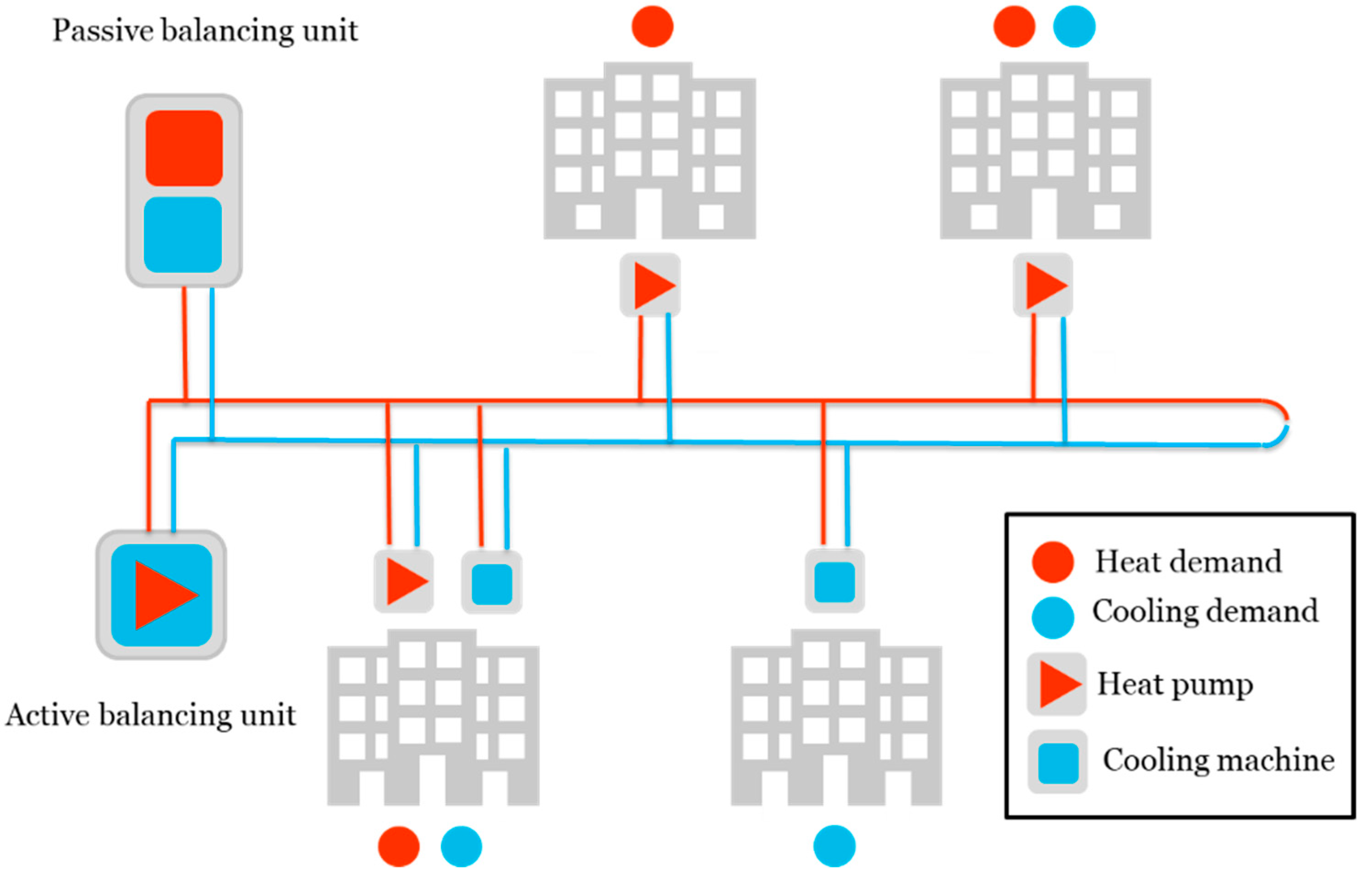
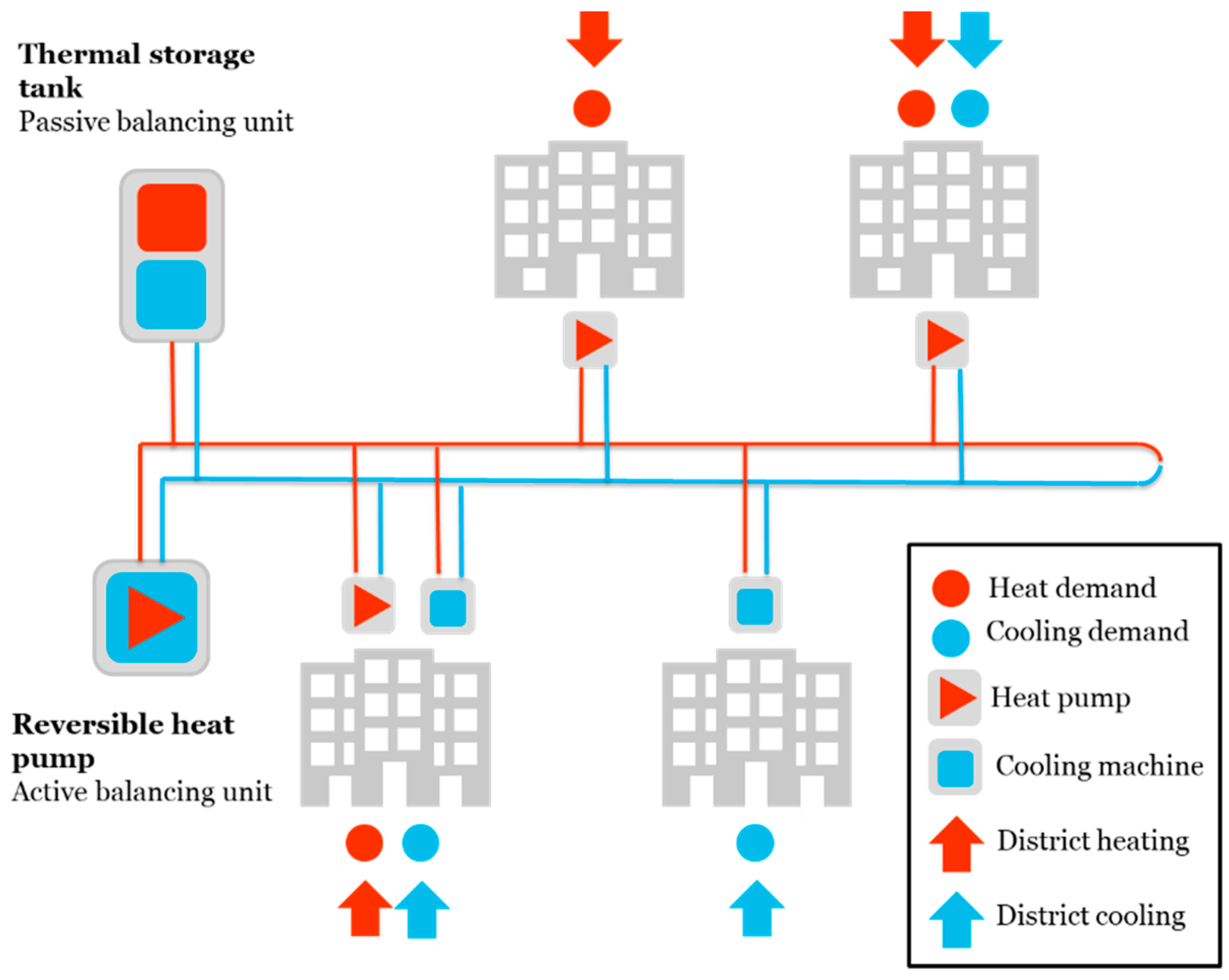
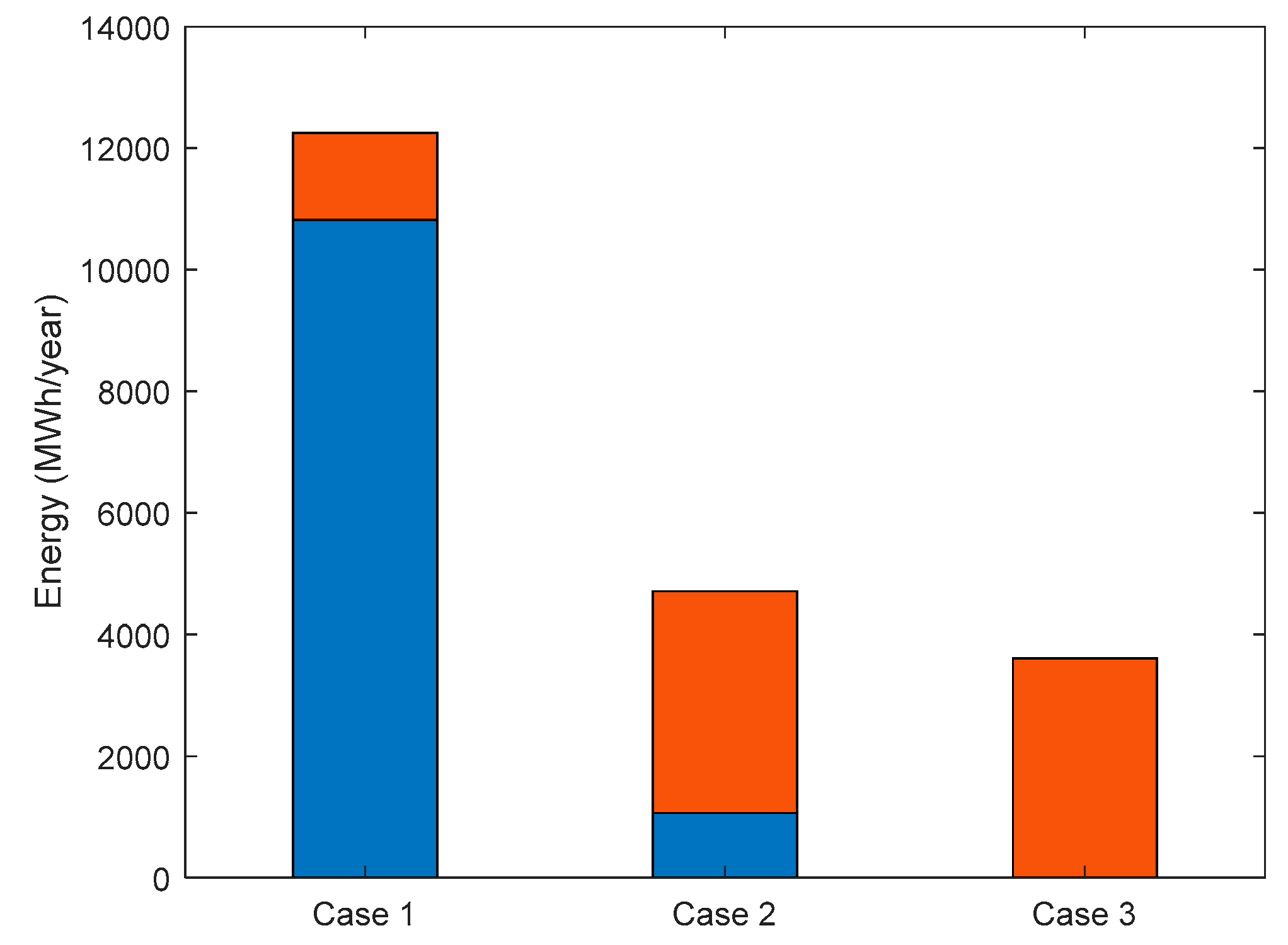

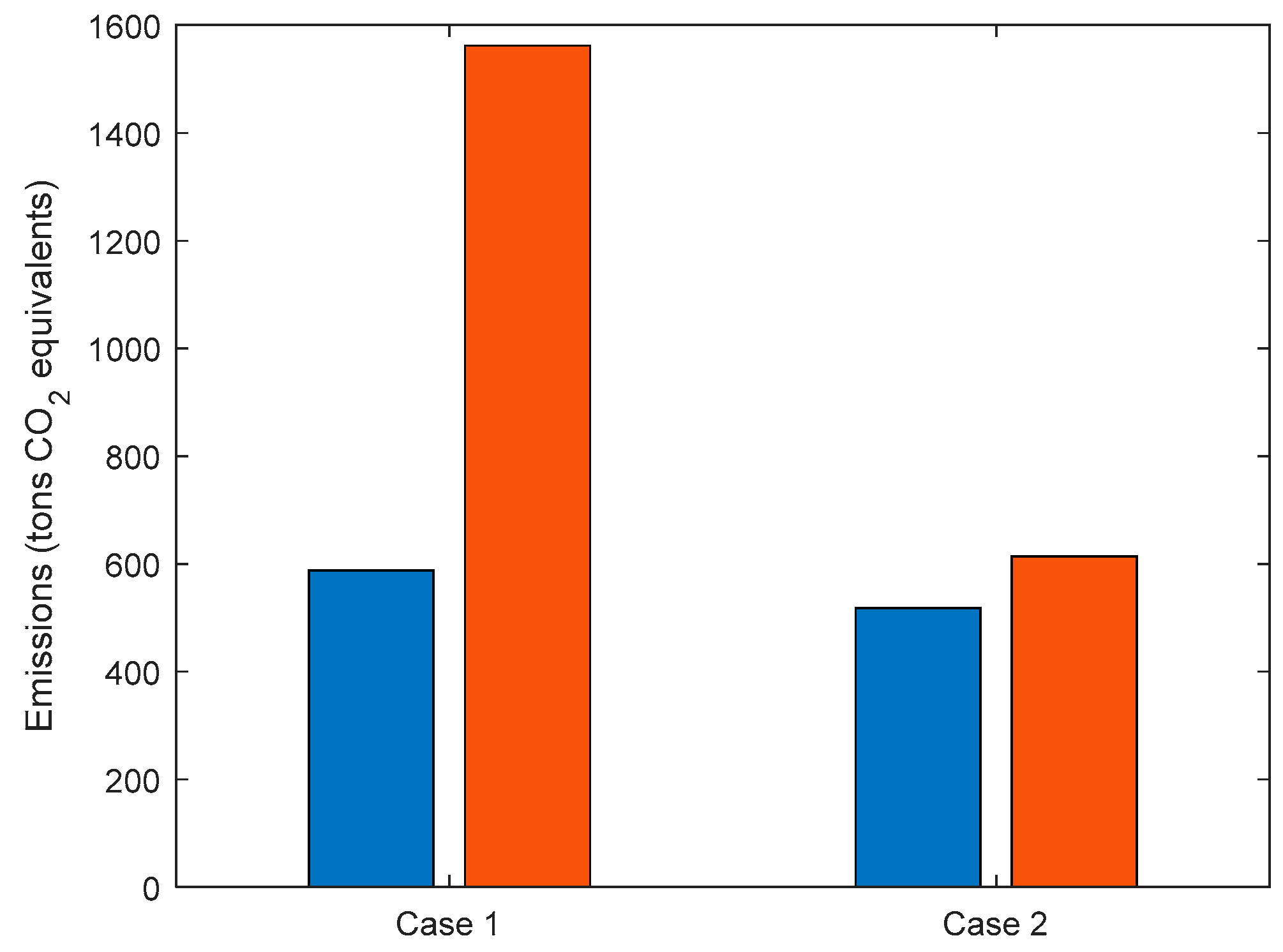

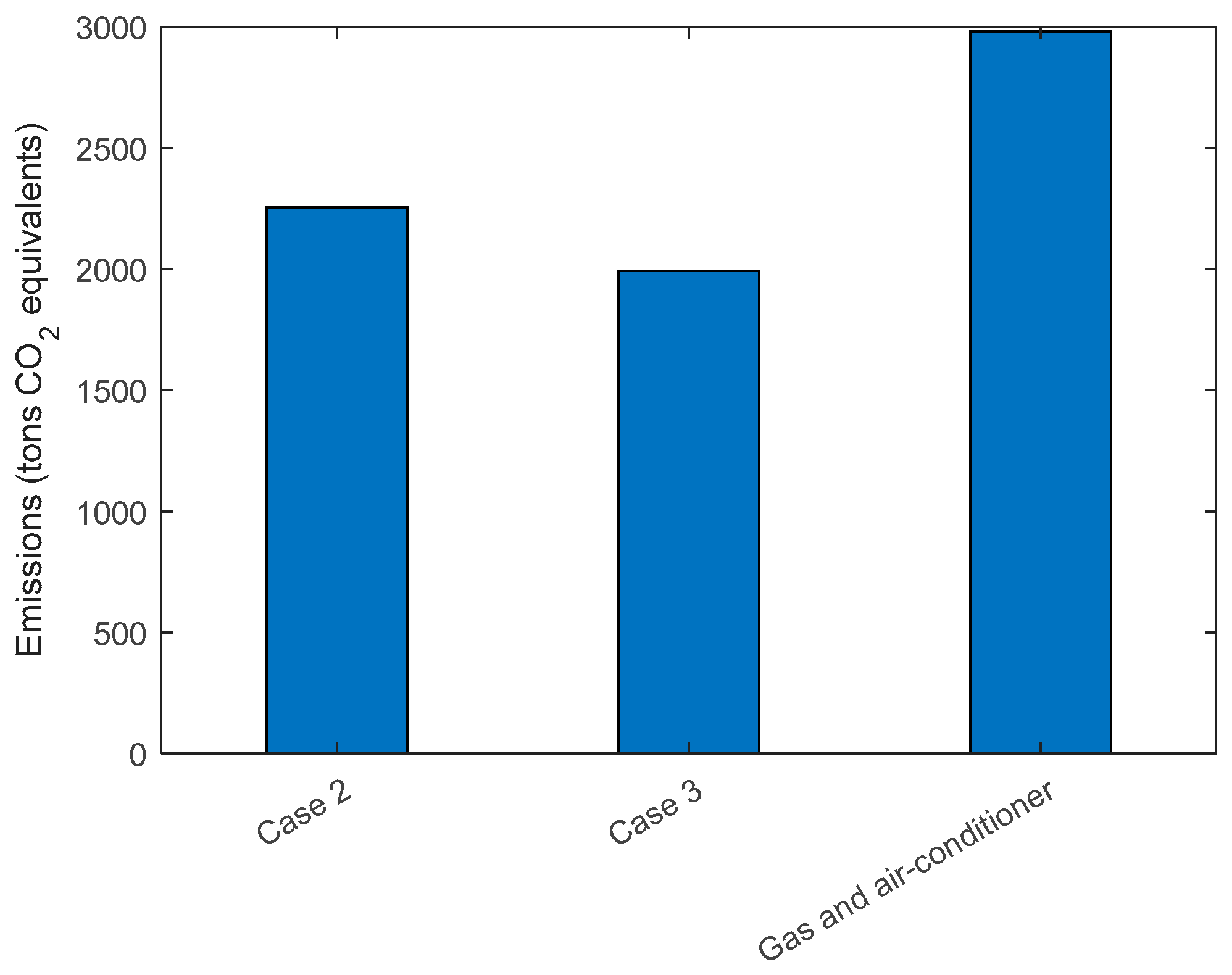
| Parameter | Explanation | Value |
|---|---|---|
| Inner diameter of the pipe (m) | 0.090 | |
| Outer diameter of the pipe (m) [32] | 0.103 | |
| Length of the pipe (m) | 5000 | |
| Thermal conductivity (W/mK) [33] | 0.465 |
| Energy Carrier | Emission Factor (g CO2 equivalents/kWh) |
|---|---|
| District heating, Lund [37] | 31.0 |
| Nordic electricity production mix [35] | 131.2 |
| District Heating System | Emission Factor (g CO2 equivalents/kWh) |
|---|---|
| Lund | 31.0 |
| Malmö | 127.0 |
| Scenario | Emission Factor (g CO2 equivalents/kWh) |
|---|---|
| Nordic residual electricity [38] | 336.4 |
| Nordic electricity mix [35] | 131.2 |
| Wind power [24] | 15.2 |
| Scenario | Emission Factor (g CO2 equivalent/kWh) |
|---|---|
| European electricity mix [40] Combustion of natural gas in a local boiler [41] | 522.0 227.0 |
| Case | Energy Use (MWh) | Emission (tons of CO2 equivalents) |
|---|---|---|
| Conventional district heating and cooling Smart energy solution for heating and cooling (ectogrid™) | 12,253 4713 | 590 510 |
| Geothermal energy | 3612 | 470 |
© 2019 by the authors. Licensee MDPI, Basel, Switzerland. This article is an open access article distributed under the terms and conditions of the Creative Commons Attribution (CC BY) license (http://creativecommons.org/licenses/by/4.0/).
Share and Cite
Franzén, I.; Nedar, L.; Andersson, M. Environmental Comparison of Energy Solutions for Heating and Cooling. Sustainability 2019, 11, 7051. https://doi.org/10.3390/su11247051
Franzén I, Nedar L, Andersson M. Environmental Comparison of Energy Solutions for Heating and Cooling. Sustainability. 2019; 11(24):7051. https://doi.org/10.3390/su11247051
Chicago/Turabian StyleFranzén, Ida, Linnéa Nedar, and Maria Andersson. 2019. "Environmental Comparison of Energy Solutions for Heating and Cooling" Sustainability 11, no. 24: 7051. https://doi.org/10.3390/su11247051
APA StyleFranzén, I., Nedar, L., & Andersson, M. (2019). Environmental Comparison of Energy Solutions for Heating and Cooling. Sustainability, 11(24), 7051. https://doi.org/10.3390/su11247051





